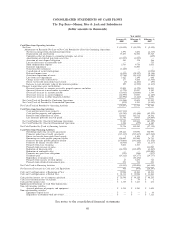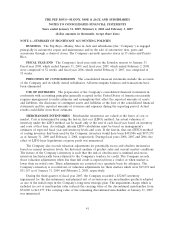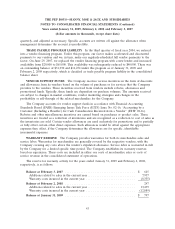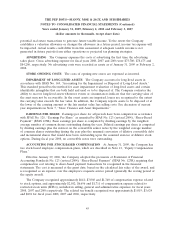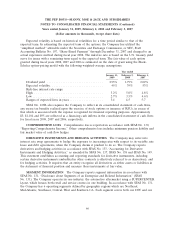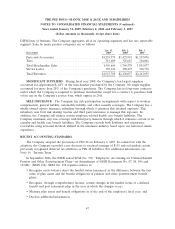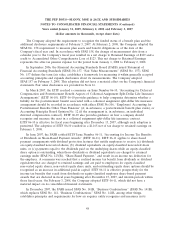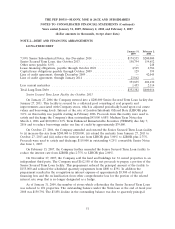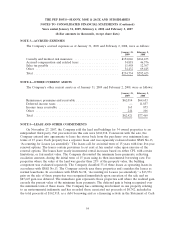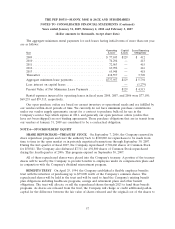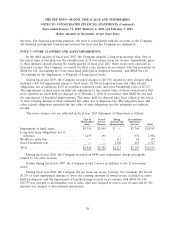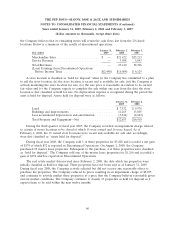Pep Boys 2008 Annual Report Download - page 114
Download and view the complete annual report
Please find page 114 of the 2008 Pep Boys annual report below. You can navigate through the pages in the report by either clicking on the pages listed below, or by using the keyword search tool below to find specific information within the annual report.THE PEP BOYS—MANNY, MOE & JACK AND SUBSIDIARIES
NOTES TO CONSOLIDATED FINANCIAL STATEMENTS (Continued)
Years ended January 31, 2009, February 2, 2008 and February 3, 2007
(dollar amounts in thousands, except share data)
accordance with SFAS No. 162, the sources of accounting principles that are generally accepted are
categorized in descending order of authority as follows: (a) FASB Statements of Financial Accounting
Standards and Interpretations, FASB Statement No. 133 Implementation Issues, FASB Staff Positions,
and American Institute of Certified Public Accountants (AICPA) Accounting Research Bulletins and
Accounting Principles Board Opinions that are not superseded by actions of the FASB (b) FASB
Technical Bulletins and, if cleared by the FASB, AICPA Industry Audit and Accounting Guides and
Statements of Position (c) AICPA Accounting Standards Executive Committee Practice Bulletins that
have been cleared by the FASB, consensus positions of the FASB Emerging Issues Task Force (EITF),
and the Topics discussed in Appendix D of EITF Abstracts (d) Implementation guides (Q&As)
published by the FASB staff, AICPA Accounting Interpretations, AICPA Industry Audit and Accounting
Guides and Statements of Position not cleared by the FASB, and practice. SFAS No. 162 is effective
60 days after the SEC’s approval of the PCAOB’s amendments to AU Section 411. The SEC approved
SFAS No. 162 on September 16, 2008. The adoption of SFAS No. 162 did not affect our financial
condition, results of operations or cash flows.
In June 2008, the FASB issued FSP EITF 03-6-1, ‘‘Determining Whether Instruments Granted in
Share-Based Payment Transactions Are Participating Securities’’ (FSP EITF 03-6-1). The FSP addresses
‘‘whether instruments granted in share-based payment transactions are participating securities prior to
vesting and, therefore, need to be included in the earnings allocation in computing EPS under the
two-class method outlined in SFAS No. 128, ‘‘Earnings per Share’’. The FASB concluded that all
outstanding unvested share-based payment awards that contain rights to non-forfeitable dividends
participate in undistributed earnings with common shareholders. Under SFAS No. 128, restricted shares
are better termed non-vested and are accounted for under SFAS No. 123(R) ‘‘Share-Based Payment’’
which requires accounting for the non-vested shares under the treasury stock method. This statement is
effective for financial statements issued for fiscal years beginning after December 15, 2008, and interim
periods within those years. The Company does not expect that the adoption of EITF 03-6-1 will have a
material impact on our calculation of earnings per share.
In September 2008, the EITF reached a consensus on Issue Number 08-5, ‘‘Issuer’s Accounting for
Liabilities Measured at Fair Value with a Third-Party Credit Enhancement’’ (EITF 08-5). The Task
Force reached a consensus that an issuer of a liability with a third-party credit enhancement that is
inseparable from the liability must treat the liability and the credit enhancement as two units of
accounting. Under the consensus, the fair value measurement of the liability does not include the effect
of the third-party credit enhancement; therefore, changes in the issuer’s credit standing without the
support of the credit enhancement affect the fair value measurement of the issuer’s liability. Entities
will need to disclose the existence of any third-party credit enhancements related to their liabilities that
are within the scope of this Issue (i.e., that are measured at fair value). The Company does not expect
the adoption of EITF 08-5 to have a material impact on its financial condition, results of operations or
cash flows.
50


